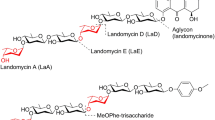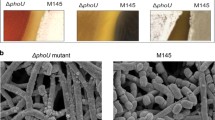Summary
The XylS protein is the positive regulator of the TOL plasmid-encoded meta-cleavage pathway for the metabolism of alkylbenzoates in Pseudomonas putida. This protein is activated by a variety of benzoate analogues. To elucidate the functional domains of the regulator and their interactions, several fusions of the XylS C-terminus to MS2 polymerase and of the N-terminus to β-galactosidase were constructed but all are inactive. In addition, 15 double mutant xylS genes were constructed in vitro by fusing parts of various mutant genes to produce mutant regulators exhibiting C-terminal and N-terminal amino acid substitutions. The phenotypic properties of the parental single mutant genes, and those of the double mutant genes, suggest that the C-terminal region is involved in binding to DNA sequences at the promoter of the meta-cleavage pathway operon, and that the benzoate effector binding pocket includes critical residues present at both the N-terminal and C-terminal ends of the protein. The intraallelic dominance of the Ile229 (Ser229 → Ile) and Val274 (Asp274 → Val) substitutions over the N-terminal His4l (Arg4l → His) substitution, and the intraallelic dominance of Thr45 (Arg45 → Thr) over Ile229 and Val274, support the proposal that these two regions of the regulator interact functionally. Combination of the Leu88 (Trp88 → Leu) and Arg256 (Pro256 → Arg) substitutions did not suppress the semiconstitutive phenotype conferred by Leu88, but resulted in a protein with altered ability to recognize benzoates. In contrast, the Leu88 semiconstitutive phenotype was suppressed by Va1288 (Asp288 → Val), and the double mutant was susceptible to activation by benzoates. The results suggest that intramolecular interactions between the C- and N-terminal regions of XylS are critical for activation of the regulator by the effector.
Similar content being viewed by others
References
Adhya S, Garges S (1990) Positive control. J Biol Chem 265:10797–10800
Brunelle A, Schleif R (1989) Determining residue-base interactions between AraC protein and araI DNA. J Mol Biol 209:607–622
Dente L, Cesarini G, Cortese R (1983) pEMBL: a new family of single stranded plasmids. Nucleic Acids Res 11:1645–1655
Franklin FCH, Bagdasarian M, Bagdasarian MM, Timmis KN (1981) Molecular and functional analysis of TOL plasmid pWWO from Pseudomonas putida and cloning of the entire regulated aromatic ring meta-cleavage pathway. Proc Natl Acad Sci USA 78:7458–7462
Gilkes NR, Warren RAJ, Miller RC, Kilburn DG (1988) Precise excision of the cellulose binding domain from two Cellulomonas fimi cellulases by a homologous protease and the effect on catalysis. J Biol Chem 263:10401–10407
Gordon AJE, Glickman BW (1988) Protein domain structure influences observed distribution of mutation. Mutat Res 208:105–108
Henikoff S, Haughn G, Calvo JM, Wallace JC (1988) A large family of bacterial activator proteins. Proc Natl Acad Sci USA 85:6602–6606
Henikoff S, Wallace JC, Brown JP (1990) Finding protein similarities with nucleotide sequence databases. Methods Enzymol 138:111–132
Inouye S, Nakazawa A, Nakazawa T (1981) Molecular cloning of gene xylS of the TOL plasmid: evidence for positive regulation of the xylDEGF operon by xylS. J Bacteriol 148:413–418
Inouye S, Nakazawa A, Nakazawa T (1987) Overproduction of the xylS gene product and activation of the xylDLEGF operon on the TOL plasmid. J Bacteriol 169:3587–3592
Kunkel RA, Roberts JD, Zakour RA (1987) Rapid and efficient site specific mutagenesis without phenotypic selection. Methods Enzymol 154:367–381
Lauble H, Georgalis Y, Heinemann U (1989) Studies on the domain structure of the Salmonella typhimurium AraC protein. Eur J Biochem 185:319–325
Maniatis T, Fritsch EF, Sambrook J (1982) Molecular cloning: a laboratory manual. Cold Spring Harbor Laboratory Press, Cold Spring Harbor, New York
Menon KP, Lee NL (1990) Activation of ara operons by a truncated AraC protein does not require inducer. Proc Natl Acad Sci USA 87:3708–3712
Mermod N, Ramos JL, Lehrbach PR, Timmis KN (1986) Vector for regulated expression of cloned genes in a wide range of Gram negative bacteria. J Bacteriol 167:447–457
Mermod N, Ramos JL, Bairoch A, Timmis KN (1987) The xylS gene positive regulator of TOL plasmid pWWO: Identification, sequence analysis and overproduction leading to constitutive expression of meta cleavage operon. Mol Gen Genet 207:349–354
Miller JM (1972) Experiments in molecular genetics. Cold Spring Harbor Laboratory Press. Cold Spring Harbor, New York
Ninfa AJ, Ninfa EG, Lupas AN, Stock A, Magasanik B, Stock J (1988) Crosstalk between bacterial chemotaxis signal transduction proteins and regulators of transcription of the Ntr regulon: Evidence that nitrogen assimilation and chemotaxis are controlled by a common phosphotransfer mechanism. Proc Natl Acad Sci USA 85:5492–5496
Pabo CO, Sauer RT (1984) Protein-DNA recognition. Annu Rev Biochem 53:293–321
Raibaud O, Schwartz M (1984) Positive control of transcription initiation in bacteria. Annu Rev Genet 18:173–206
Ramos JL, Stolz A, Reineke W, Timmis KN (1986) Altered effector specificities in regulators of gene expression: TOL plasmid xylS mutants and their use to engineer expansion of the range of aromatics degraded by bacteria. Proc Natl Acad Sci USA 83:8467–8471
Ramos JL, Michan C, Rojo F, Dwyer D, Timmis KN (1990a) Signal-regulator interactions: Genetic analysis of the effector binding site of xylS, the benzoate-activated positive regulator of Pseudomonas TOL plasmid meta-cleavage pathway operon. J Mol Biol 211:373–382
Ramos JL, Rojo F, Zhou L, Timmis KN (1990b) A family of positive regulators related to the Pseudomonas putida TOL plasmid Xy1S and the Escherichia coli AraC activators. Nucleic Acids Res 18:2149–2152
Ronson CW, Nixon BT, Ausubel FM (1987) Conserved domains in bacterial regulatory proteins that respond to environmental stimuli. Cell 49:579–581
Strebel K, Beck E, Strohmaier OK, Schaller H (1986) Characterization of foot-and-mouth disease virus gene products with antisera against bacterially synthesized fusion proteins. J Bacteriol 57:983–991
Wootton JC, Drummond MH (1989) The Q-linker: a class of interdomain sequences found in bacterial multidomain regulatory proteins. Protein Eng 2:535–543
Zhou L, Timmis KN, Ramos JL (1990) Mutations leading to constitutive expression from the TOL plasmid meta-cleavage pathway operon are located at the C-terminal end of the positive regulator XylS protein. J Bacteriol 172:3707–3710
Zoller MJ, Smith M (1983) Oligonucleotide-directed mutagenesis of DNA fragments cloned into M13 vectors. Methods Enzymol 100:468–500
Author information
Authors and Affiliations
Additional information
Communicated by H. Hennecke
Rights and permissions
About this article
Cite this article
Michán, C., Kessler, B., de Lorenzo, V. et al. XylS domain interactions can be deduced from intraallelic dominance in double mutants of Pseudomonas putida . Molec. Gen. Genet. 235, 406–412 (1992). https://doi.org/10.1007/BF00279387
Received:
Accepted:
Issue Date:
DOI: https://doi.org/10.1007/BF00279387




